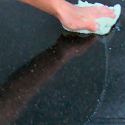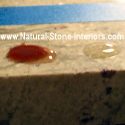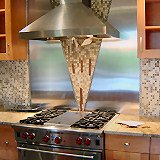 | |||||||||||||||||||||||||||||||||||
|
Loading
| |||||||||||||||||||||||||||||||||||
Granite Countertop SanitationGranite Ranked First...
Article On Granite Countertop Sanitation By: Marble Institute of America
The key safety issue to the consumer is the degree of cleanability of the surface material, that is, how easily any contaminants can be removed using normal and reasonable cleaning practices. The following study by Dr. O. Peter Snyder of the Hospitality Institute of Technology and Management used E. coli bacteria as its contaminating agent. The findings of the report show significant cleanability advantages of natural granite countertops over almost all other commonly found countertop surface materials. The study included six countertop surfaces which were washed and rinsed after exposure to the bacteria. They were later cleaned with a 10% solution of white household vinegar (1 part 5% vinegar, 9 parts water). Bacteria counts were taken after both cleaning methods. Granite Ranked 1st in cleanability. After washing and rinsing, the granite tops provided the greatest reduction in bacteria counts of all the countertop materials tested:
Counts taken after the application of the diluted vinegar solution showed the granite having a bacteria count reduction second only to stainless steel, but 160 times better than the next closest material:
This technical bulletin contains general guidelines. The Marble Institute of America and its Member companies are not responsible for any use or misuse that causes damage of any kind, including loss of rights, materials, and personal injury alleged to be caused directly or indirectly by the information contained in this document.
We have reprinted Dr. Snyder's study on granite countertop sanitation & other countertop surfaces in its entirety herein for your review. Here's MORE Granite STUFF:
Return from Granite Countertop Sanitation to Granite Counter Tops Info Return from Granite Countertop Sanitation to Natural Stone Interiors Home |
|
||||||||||||||||||||||||||||||||||
|
|
|||||||||||||||||||||||||||||||||||
|
Top Of Page | Home Page | What's New | Free Estimates | Site Map | Privacy Policy | Advertising | Contact Us | | |||||||||||||||||||||||||||||||||||
|
Copyright © 2005 - 2015 Natural-Stone-Interiors.com - All Rights Reserved.
|
|||||||||||||||||||||||||||||||||||










